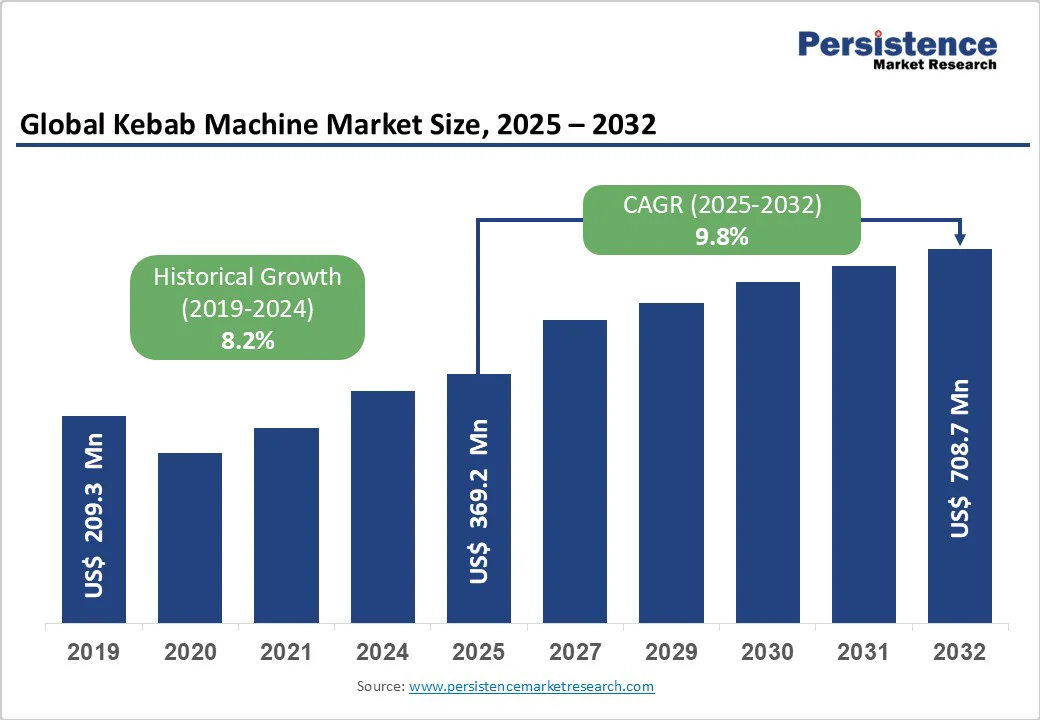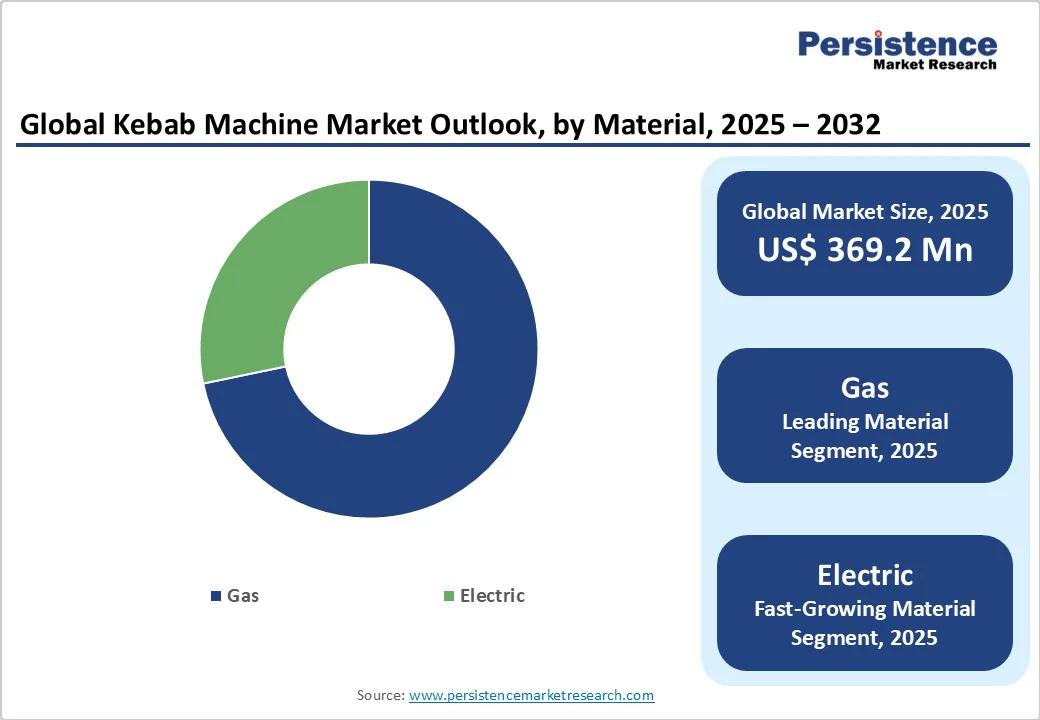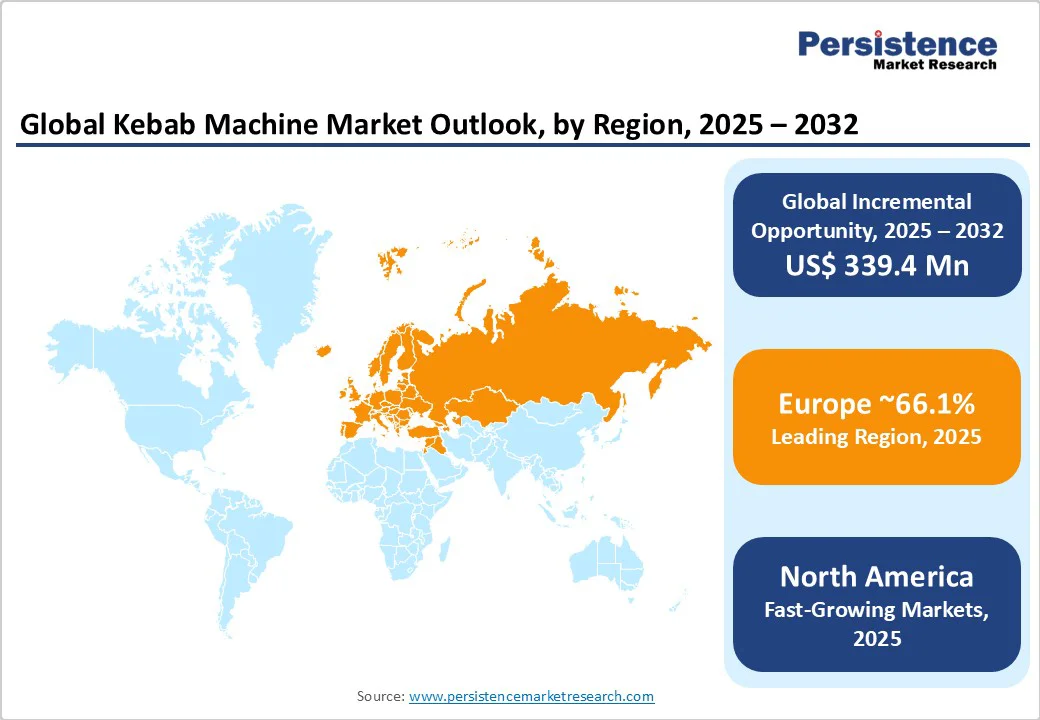ID: PMRREP35693| 189 Pages | 8 Oct 2025 | Format: PDF, Excel, PPT* | Industrial Automation

The global kebab machine market size is likely to value at US$ 369.2 million in 2025 and is projected to reach US$ 708.7 million by 2032, growing at a CAGR of 9.8% between 2025 and 2032. The global kebab machine market is experiencing robust growth, driven by the increasing popularity of Middle Eastern, Mediterranean, and South Asian cuisines, along with rising demand for efficient, automated food preparation solutions in commercial kitchens.
| Key Insights | Details |
|---|---|
|
kebab machine Market Size (2025E) |
US$ 369.2 Mn |
|
Market Value Forecast (2032F) |
US$ 708.7 Mn |
|
Projected Growth (CAGR 2025 to 2032) |
9.8% |
|
Historical Market Growth (CAGR 2019 to 2024) |
8.2% |

The expanding appreciation for Middle Eastern, Mediterranean, and South Asian culinary traditions represent a primary growth catalyst, with kebabs gaining widespread acceptance beyond traditional markets. The U.S. Bureau of Labor Statistics projects 10% growth in the foodservice industry from 2022 to 2032, directly benefiting kebab preparation equipment demand. The foodservice industry's growth rate of 10% from 2022 to 2032 as reported by the U.S. Bureau of Labor Statistics directly correlates with increased kebab machine adoption across restaurants, food trucks, and catering establishments. Commercial establishments increasingly prioritize speed, hygiene, and consistency, driving investments in specialized machinery that delivers standardized quality while reducing labor dependency.
Industry 4.0 principles are transforming kebab machine capabilities through IoT integration, smart temperature controls, and predictive maintenance systems. Modern machines feature automated rotation systems, energy efficient heating elements, and digital monitoring interfaces that optimize cooking precision while minimizing energy consumption. The development of multi-functional machines capable of handling diverse protein types, including plant-based alternatives, addresses evolving consumer preferences and market diversification. Energy efficiency compliance with regulatory standards, particularly in European markets, drives adoption of advanced electric and hybrid systems.
Capital intensity remains a significant barrier for the kebab machine market, particularly for small-scale vendors and startups in emerging economies where lower consumer purchasing power makes return-on-investment justification difficult. Advanced kebab machines demand substantial upfront investments, and in high-volume commercial settings, frequent maintenance and component replacement further increase operational expenses. Additionally, supply chain disruptions affecting specialized components and imported machinery parts can lead to delivery delays and cost escalations, reducing market accessibility for many businesses.
Compounding these financial challenges are complex regulatory landscapes across different regions. Compliance with food safety standards, energy efficiency requirements, and certification processes often incurs considerable costs. Manufacturers may face delayed product launches and higher development expenses while navigating diverse international regulations. In particular, stringent food safety standards enforced by organizations such as the European Food Safety Authority (EFSA) require continuous innovation in hygiene features and maintenance protocols, adding pressure on producers to adapt quickly.
Asia Pacific markets, particularly China, India, and Japan, present substantial growth potential driven by expanding middle class populations, rising disposable incomes, and increasing exposure to international cuisines. Latin American markets offer untapped opportunities as Brazil and Argentina experience growing outdoor cooking trends and cultural food diversification. The Middle East and Africa regions benefit from traditional kebab culture while demanding modern, efficient preparation technologies.
AI and IoT-enabled machines with predictive maintenance, operational analytics, and remote monitoring capabilities represent significant value addition opportunities. Sustainability initiatives driving demand for energy efficient, eco-friendly machines align with environmental regulations and corporate responsibility objectives. Plant based protein processing capabilities and multi protein machine development address expanding dietary preferences and market diversification trends.
Gas powered kebab machines maintain market dominance with an estimated 66.1% market share in 2025, driven by their superior heat control, fast ignition capabilities, and operational cost effectiveness. These systems offer dual compatibility with natural gas and propane, making them particularly attractive across diverse geographic markets including the U.S., Middle East, and Asia. Commercial kitchens favor gas units for their consistent flame delivery and energy efficiency in high throughput environments.
Electric kebab machines are projected to reach USD 635.9 million by 2032, as regulatory emphasis on clean indoor cooking and emissions control drives adoption. Energy efficient designs and improved aesthetic appeal for modern kitchen environments enhance electric model penetration in urban restaurants and health-conscious establishments. Safety considerations and workplace standards compliance further support electric segment expansion.
Manual kebab machines account for more than 60% of global sales in 2025, preferred for the precision and control they offer in meat grilling, rotation, and searing processes. These machines appeal to culinary establishments where customization and artisanal quality remain paramount, particularly in developing economies where cost effectiveness drives purchasing decisions. Manual operation allows skilled operators to adjust cooking parameters based on specific recipe requirements and customer preferences.
The automatic segment experiences faster growth compared to manual alternatives due to increased operational efficiency and reduced labor costs. High volume commercial kitchens increasingly adopt automated systems to ensure consistent output quality while addressing labor shortage challenges in the foodservice industry. Technological advancements in automation enable programmable cooking cycles and temperature management that enhance productivity.
The commercial application represents the largest market portion, driven by expanding restaurant networks, food truck proliferation, and catering service growth. Commercial kebab machines are engineered for high-capacity operations, featuring heavy duty construction and rapid production capabilities essential for quick service restaurants and street food vendors. The expansion of fast casual dining and international fast food chains fuels sustained demand in the commercial segment.
The residential segment exhibits moderate growth, driven by consumer interest in home cooking and outdoor entertainment, which in turn fuels demand for compact, affordable kebab machines. Backyard barbecue culture and family gathering trends support household segment expansion, with manufacturers developing user-friendly, easy-to-maintain models for home chefs. Online retail penetration facilitates household market access through e-commerce platforms and direct-to-consumer sales.
The kebab machine market operates through two primary sales channels: offline and online distribution networks. Offline channels maintain market dominance, with specialty food equipment retailers capturing more than 60% revenue in 2025. This segment includes direct manufacturer sales, authorized distributors, and commercial kitchen equipment dealers serving large-scale buyers requiring technical consultations, installation assistance, and comprehensive service packages.
Online sales channels experience accelerated growth driven by digital transformation and enhanced convenience factors. B2B e-commerce platforms, manufacturer websites, and marketplace aggregators enable comprehensive product comparisons, transparent pricing, and 24/7 accessibility. The COVID-19 pandemic accelerated online adoption, particularly among small and medium-sized businesses seeking streamlined procurement processes. Leading manufacturers adopt omnichannel strategies integrating online product discovery with offline technical support. Regional preferences vary, with developed markets showing higher online adoption while emerging markets maintain offline dependencies due to relationship-based business cultures and infrastructure limitation

Europe has become the undisputed leader in global kebab machine demand, driven by cultural diversity, advanced foodservice technology, and strong consumer appetite for authentic Mediterranean cuisine. Europe is the epicenter for global kebab machine market with the revenue share of 38% in 2025. Germany, the U.K., France, and Spain dominate the market, fueled by a long established Middle Eastern and Mediterranean restaurant presence. Germany remains the kebab capital of Europe, boasting over 16,000 kebab shops and an average consumption of 3.5 kg per capita annually. According to FoodTimes, Turkey is the world’s leading producer of kebabs, but Germany, supported by its large Turkish diaspora, commands over 30% of total European sales, followed closely by the U.K. and France.
The European kebab market was valued at €2.5 billion in 2022 and is projected to expand at a CAGR of 4.5% from 2023 to 2028, propelled by growing convenience food demand, late night dining culture, and the rapid expansion of quick service restaurants (QSRs). Per capita consumption figures reinforce this trend: U.K. (2.8 kg), France (2.2 kg), Netherlands (1.8 kg), Austria (1.5 kg), and Italy (0.8 kg). This surge in consumption sustains high demand for kebab machines, particularly equipment capable of meeting authentic preparation standards.
EU sustainability initiatives and European Food Safety Authority (EFSA) compliance requirements further elevate demand for advanced, energy efficient kebab machines that ensure safety, hygiene, and environmental responsibility. Equipment manufacturers investing in AI and IoT enabled technologies gain a competitive edge, as predictive maintenance and operational analytics reduce downtime and increase profitability for foodservice operators.
North America is the fastest-growing market for kebab machines and projected to reach USD 210 million by 2032. A robust foodservice industry fuels growth owing to the extensive restaurant networks, fast food chains, and catering services that increasingly rely on efficient kebab preparation solutions.
The surging popularity of Middle-Eastern cuisine and multicultural dining preferences across major U.S. and Canadian cities are driving sustained demand. Advanced technology adoption and high consumer spending on premium cooking appliances further boost market expansion, supported by a strong outdoor cooking and barbecue culture.
Strict food safety regulations create demand for certified, hygienic kebab machines, ensuring compliance with stringent sanitation standards. Simultaneously, investment in energy-efficient equipment aligns with sustainability goals and cost reduction strategies. North America’s innovation ecosystem driven by technology partnerships and product development strengthens competitive positioning, making the region a highly lucrative growth hub for kebab machine manufacturers and investors.

The global kebab machine market is moderately concentrated, with leading manufacturers leveraging product innovation, automation, and geographic expansion to maintain competitive advantages. Established players balance against emerging regional manufacturers, creating a dynamic environment that accelerates technological advancement and cost optimization. Companies such as Crown Verity have enhanced their luxury BBQ and professional kitchen portfolios, targeting North American culinary professionals with advanced outdoor cooking solutions. Kebapchef, a specialist in Turkish barbecue equipment, has achieved global recognition through industrial kitchen appliance innovations, while ANKO’s SD 97 Series integrates IoT and Big Data Analytics for smart kebab production lines.
European manufacturers are aggressively expanding into Asia Pacific to tap rising foodservice demand, while mergers and acquisitions are reshaping the landscape as large kitchen equipment firms acquire niche kebab machine producers to broaden offerings. Strategic partnerships between manufacturers and technology providers foster innovation in smart machines and automation. Leading strategies emphasize automation, energy efficiency, cost leadership, and service-based business models, including maintenance contracts and digital platform integration to strengthen global market positioning.
The kebab machine market is estimated to be valued at US$ 332.4 Mn in 2025.
Growing global demand for ethnic cuisines and fast casual dining is the key demand driver for the kebab machine market.
In 2025, the Europe region will dominate the market with an exceeding 38% revenue share in the global kebab machine market.
Among operation type, manual operation of kebab machine holds the highest preference, capturing beyond 60% of the market revenue share in 2025, surpassing automatic operation.
The key players in the automotive catalytic converter market are Kebapchef, Crown Verity, Lavna, Wellberg, GastroProdukt, Tasty Trotter, Apuro , and Zz Pro.
| Report Attribute | Details |
|---|---|
|
Historical Data/Actuals |
2019 - 2024 |
|
Forecast Period |
2025 - 2032 |
|
Market Analysis Units |
Value: US$ Mn, Volume: Units |
|
Geographical Coverage |
|
|
Segmental Coverage |
|
|
Competitive Analysis |
|
|
Report Highlights |
|
By Fuel Type
By Operation
By Application
By Sales Channel
By Region
Delivery Timelines
For more information on this report and its delivery timelines please get in touch with our sales team.
About Author